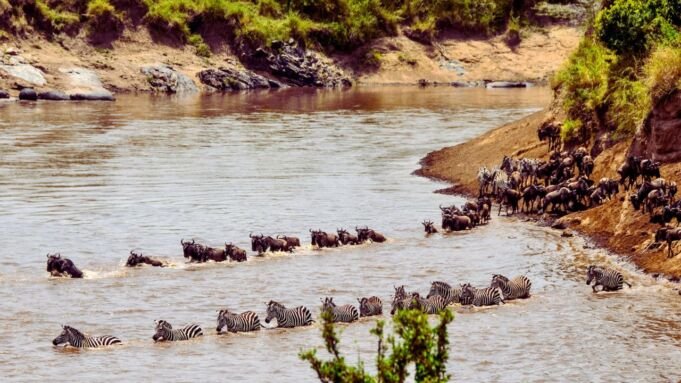The annual wildebeest river crossings in the Serengeti and Maasai Mara are one of the most awe-inspiring natural events on the planet. Each year, millions of wildebeest, along with zebras and other herbivores, undertake a treacherous journey across crocodile-infested rivers in search of greener pastures.
This phenomenon is not only a testament to the resilience and determination of these animals but also a powerful reminder of the interconnectedness and fragility of ecosystems.
What are the Wildebeest River Crossings?
The wildebeest river crossings refer to the mass migration of wildebeest, zebras, and other herbivores across the Mara River in Kenya and the Grumeti River in Tanzania. This natural spectacle occurs annually as part of the Great Migration, a continuous movement of animals in search of grazing and water.
The Great Migration and Wildebeest Behavior
The Great Migration is a continuous, year-long journey involving over 1.5 million wildebeest, accompanied by hundreds of thousands of zebras and gazelles. This epic movement spans the Serengeti in Tanzania and the Masai Mara in Kenya. River crossings are pivotal moments in this migration, as they represent both a significant physical barrier and a critical survival challenge for the herds.
Wildebeest migrate in response to seasonal rains and the availability of fresh grazing. Their movement is dictated by a combination of instinct and environmental cues. The crossings occur as the herds move northward in search of greener pastures, driven by the need to sustain the large population.
How do the Wildebeest Navigate the River Crossings?
The Wildebeest Crossings displays remarkable coordination and adaptability during the river crossings. They gather in large herds on the riverbanks, often hesitating for hours before plunging into the water. Once the first few brave individuals leap, the rest follow in a frenzied rush, creating a chaotic yet awe-inspiring spectacle.
Key Wildebeest River Crossings
Mara River
The Mara River, located in the Masai Mara, is perhaps the most famous crossing point. The crossings here typically occur between July and October, peaking in August and September. This river poses numerous challenges, including strong currents and a high density of crocodiles lying in wait for the migrating herds.
Grumeti River
The Grumeti River, situated in the western Serengeti, is another critical crossing point. Crossings here generally take place between May and July. Although less well-known than the Mara, the Grumeti River crossings are equally perilous, with steep banks and resident crocodiles posing significant threats.
The Wildebeest River Crossings Process
Preparation
As the herds gather at the riverbanks, there is a palpable tension in the air. Wildebeests exhibit nervous behavior, moving back and forth along the banks, as they muster the courage to cross. This hesitation is partly due to the visible dangers and the instinctual fear of the unknown.
The Crossing
Once a few brave individuals take the plunge, the rest of the herd follows in a frantic, thundering rush. The crossing itself is chaotic, with wildebeest jostling for position, battling strong currents, and trying to avoid lurking crocodiles. The herd mentality plays a crucial role here, as the sheer number of animals crossing together provides some level of protection against predators.
Post-Crossing
After the crossing, the herds reassemble on the other side, often in a state of exhaustion. The immediate aftermath involves the herd regrouping and tending to any injured members. Despite the ordeal, the wildebeest quickly resumes their march, driven by the ongoing need to find food and water.
Best Time to See The Migration River Crossings
Every year, millions of wildebeests and zebras journey across the Serengeti in search of fresh water and grass. This migration occurs year-round, and your tour operator can advise on the best times and places to visit.
The Grumeti River is a notable highlight. Survival of the fittest is evident here as only the strong survive the Nile crocodiles infesting the water. The sights and photographs from this area are stunning.
August and September are the best months to witness the Great Migration, with higher chances of seeing a river crossing. In early October, the rainy season in Tanzania begins, and the herds start their return journey to the Serengeti.
A safari to the Grumeti River is rewarding almost year-round. June and July offer the best views as animals cross the crocodile-infested river, making their way to the Masai Mara National Park in Kenya, an extension of the Serengeti.
Hungry crocodiles wait for crossing wildebeests and zebras; only the strong and fast survive. Many drown, break their legs, or become prey to other animals.
Some prefer visiting in September and October, post-migration, when large herds of zebra and wildebeest, along with elephants, topi, and Thomson’s gazelle, safely quench their thirst on the river’s sandy shores.
What is the Significance of the Wildebeest River Crossings?
Beyond being a visual spectacle, the Wildebeest River crossings hold immense ecological significance. The nutrient-rich carcasses of wildebeest that perish during the crossings provide sustenance for scavengers and contribute to the overall balance of the ecosystem. Additionally, the crossings serve as a reminder of the delicate balance between predator and prey, and the interconnectedness of all life in the wild.
Tips for Observing River Crossings
Best Times to Visit: The best times to witness river crossings are from July to October at the Mara River and from May to July at the Grumeti River. Planning your visit during these peak periods increases the likelihood of seeing the crossings.
Recommended Locations: Key viewing spots along the riverbanks, such as designated safari camps and observation points, offer the best vantage points for observing the crossings. Guided tours with experienced rangers can enhance the experience.
Ethical Wildlife Watching: Responsible tourism is essential for preserving the ecosystem’s delicate balance. Visitors should follow guidelines to minimize disturbance, such as keeping a respectful distance, avoiding loud noises, and supporting eco-friendly operators.
What are the Challenges and Dangers Faced During the River Crossings?
The river crossings present numerous challenges and dangers for the wildebeest and other migrating animals. The Mara and Grumeti Rivers are infested with large crocodiles, which lie in wait for the vulnerable herbivores. Additionally, the strong currents and steep banks of the rivers pose physical obstacles, leading to injuries and fatalities among the crossing animals.
Conclusion
The wildebeest river crossings stand as a testament to the enduring spirit of these animals and the raw power of nature. As we witness this remarkable natural phenomenon, we are reminded of the fragility and interconnectedness of ecosystems and the importance of preserving these wonders for generations to come. The annual migration and river crossings of the wildebeest serve as a powerful symbol of the resilience and adaptability of wildlife in the face of formidable challenges.















